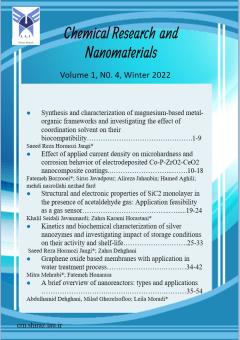Structural and electronic properties of SiC2 monolayer in the presence of acetaldehyde gas: Application feasibility as a gas sensor
Subject Areas : Applications of Nanostructures
Khalil Seidali Javanmardi
1
![]() ,
Zahra Karami Horastani
2
*
,
Zahra Karami Horastani
2
*
1 - Department of Electrical Engineering, Shiraz Branch, Islamic Azad University, Shiraz. Iran
2 - Department of Electrical Engineering, Shiraz Branch, Islamic Azad University, Shiraz. Iran
Keywords: SiC2, density functional theory, Acetaldehyde,
Abstract :
This paper investigates the influence of acetaldehyde molecule adsorption on the structural and electronic properties of the SiC2 monolayer using density functional theory. For this purpose, different adsorption sites on the monolayer were investigated and the most stable structure was reported based on the adsorption energy. The results showed that the acetaldehyde molecule is physically adsorbed on SiC2 with an energy of about 0.310 eV. Comparing the band structure and density of states of SiC2 before and after the adsorption of acetaldehyde molecule showed that the energy gap and the distance between the Fermi level and the conduction band after acetaldehyde adsorption increase by 0.008 eV and 0.006 eV, respectively, which can cause a decrease in electrical conductivity. Based on the calculations, SiC2 can be used as an acetaldehyde gas sensor based on conductivity and, reaction heat change, or as an absorbent surface in piezoelectric gas sensors.
1. D.Calestani, R.Mosca, Zanichelli, M.Villani, A.Zappettini, J. Mater. Chem., 21(39), 15532 (2011).
2. G.K.Mani, J.B.B. Rayappan, Sens. Actuators B Chem, 223, 343(2016) .
3. L.Zhang, M.Zhou, and S. Dong, Anal. Chem, 84(23),10349(2012).
4. P.Fuchs, et al., UICC, 126(11), 2663(2010).
5. P.Patil, et al., Mater Sci Semicond, 101, 76 (2019).
6. D.Klensporf, H.H. Jeleñ, Polish J. Food Nutr. Sci, 14(4), 389(2005).
7. X.Guan, E.Rubin, and H. Anni, Alcohol. Clin. Exp, 36(3), 398(2012).
8. AW.Hodgson, P.Jacquinot, LR.Jordan, PC. Hauser, Electroanalysis,;11(10‐11),782(1999).
9. P.Rai, and Y.-T. Yu, Sens. Actuators B Chem, 173, 58(2012).
10. S.Ahmadnia-Feyzabad, et al., Sens. Actuators B Chem, 166, 150(2012).
11. Y.Chu, et al., MCA, 181, 1125(2014).
12. E.Saatci, S. Natarajan, COCIS, 55, 101469(2021).
13. K.S.Novoselov, et al., J. Sci., 306(5696), 666 (2004).
14. W.Mehr, et al., IEEE Electron Device Letters, 5, 691(2012).
15. R.Wu, et al., J. Phys. Chem. C, 112(41), 15985 (2008).
16. M.Shafiei, et al. Pt/graphene nano-sheet based hydrogen gas sensor. (2009) in IEEE Sens. J.
17. Z.Yin, et al., Adv. Energy Mater, 4(1), 1300574(2014).
18. M.Z.Iqbal, and A.-U. Rehman, J. Sol. Energy, 169, 634(2018).
19. A.Ferreira, et al., Phys. Rev. B Condens. Matter, 85(11), 115438(2012).
20. H.Yao, , et al., Chin. Phys. B, 31(3), 038501(2022).
21. F.Arshad, et al., Colloids Surf. B, 112356. (2022)
22. L.Jiang, et al., MAT SCI SEMICON PROC, 138, 106252(2022).
23. J.Ni, , M. Quintana, S. Song, PHYSICA E Low-dimensional Systems and Nanostructures, 116, 113768(2020).
24. T.Y.Kim, , C.-H. Park, and N. Marzari, Nano Lett.,16, 2439(2016).
25. H.Dong, et al., NANOHL, 8(13), 6994 (2016).
26. L.Sun, et al., RSC Adv, 8(25), 13697(2018).
27. D.Fan, et al., J. Mater. Chem. C, 5(14), 356, (2017).
28. S.Lin, J. Phys. Chem. C, 116(6), 3951(2012).
29. M.Zeng, et al., Chem. Rev, 118(13), 6236 (2018).
30. P.Giannozzi, et al., J. Phys. Condens, 21(39), 5502(2009).
31. J.P.Perdew, K. Burke, and M. Ernzerhof,. PRL, 77(18), 3865(1996).
32. S.Grimme, et al., J. Chem. Phys, 132(15), 154104(2010).
33. M.F.Saadi, R. Safaiee, and M. Golshan, Appl. Surf. Sci., 481, 484 (2019).
34. H. Cui, D. Chen, Y. Zhang, X. Zhang, Sust. Mater. Technol. 17, e00094.(2019)

